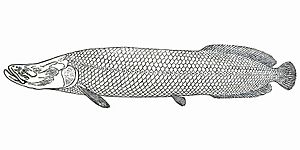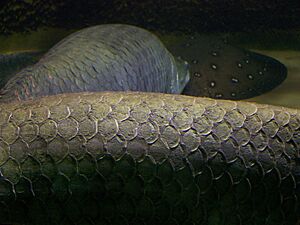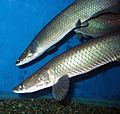Arapaima facts for kids
Quick facts for kids Arapaima |
|
|---|---|
 |
|
| Scientific classification | |
| Type species | |
| Sudis gigas Schinz, 1822
|
|
| Synonyms | |
|
The arapaima (also called pirarucu or paiche) is a giant freshwater fish found in the Amazon and Essequibo rivers of South America. These amazing fish are some of the largest freshwater fish in the world! They can grow to be as long as 3 meters (about 10 feet).
Arapaima are a very important source of food for people living in the Amazon. Sadly, their numbers have gone down because of too much fishing and losing their homes. However, they have been moved to other tropical places, sometimes causing problems for local fish. The name pirarucu comes from the Tupi language and means "red fish."
Contents
Discovering Arapaima Species
Scientists recognize several types of arapaima. It's thought there might be even more species waiting to be found in the deep parts of the Amazon. This is because these fish don't travel far, so different groups might have become unique over time.
- Arapaima arapaima
- Arapaima agassizii (Agassiz's arapaima)
- Arapaima gigas (the most well-known arapaima)
- Arapaima leptosoma (Slender arapaima)
- Arapaima mapae (Mapa arapaima)
What Does an Arapaima Look Like?

Arapaima can grow to be over 2 meters (6.5 feet) long and weigh more than 100 kilograms (220 pounds)! Some reports say they can reach 4.5 meters (15 feet), but these are hard to prove. Because of too much fishing, it's rare to find arapaima longer than 2 meters in the wild today.
These fish have a sleek, torpedo-like shape. They have large, blackish-green scales with red marks. Their fins are set close to their tail, which helps them move smoothly through the water.
Amazing Scales and Breathing
Arapaima scales are super tough! They have a hard outer layer and many layers of strong, flexible fibers underneath. This special design helps the fish bend and move while still being heavily protected. It's like wearing strong armor that lets you stay quick!
Arapaima also have a special way to breathe. Besides gills, they have a modified swim bladder that works like a lung. This allows them to breathe air from the surface, which is very helpful in the Amazon's waters, where oxygen levels can be low.
Where Arapaima Live and What They Eat
Arapaima eat fish, crabs, fruits, seeds, insects, and even small land animals that come near the water. They are known as "air breathers" because they use their special lung-like organ to get oxygen from the air. This is a big advantage in waters that don't have much oxygen.
They can even survive in lakes with very little oxygen. During the dry season, when lakes are cut off from rivers, arapaima become the top predators. Their prey become slow and easy to catch when oxygen levels drop. Arapaima might even jump out of the water if they feel trapped or bothered!
Arapaima Life and Family
How Arapaima Reproduce
The life of an arapaima is closely tied to the Amazon's wet and dry seasons. They lay their eggs when water levels are low or just starting to rise. They build a nest about 50 centimeters (20 inches) wide and 15 centimeters (6 inches) deep, usually in muddy areas. As the water rises, the eggs hatch, and the young fish have the flood season (May to August) to grow big and strong.
Parental Care
The male arapaima is a "mouthbrooder," which means he protects his young by holding them in his mouth until they are older. The female arapaima helps by swimming around the male and the young, chasing away any animals that might try to harm them.
Arapaima and Humans
People in the Amazon use arapaima in many ways. They are a popular food fish, known for their boneless meat. Locals often salt and dry the meat, rolling it into a cigar shape. This allows it to be stored without needing a refrigerator, which is very important in the Amazon. Some call arapaima the "cod of the Amazon" because it can be prepared in similar ways.
Arapaima are also kept as aquarium fish, but they need a lot of space and food! Their bony tongue is used to scrape dried guarana (an ingredient in some drinks). Their tough scales are even used as nail files!
Recently, designers have started using arapaima skin as a type of leather to make jackets, shoes, handbags, and even to cover furniture.
Arapaima Sightings in Other Countries
Sometimes, arapaima are spotted in places far from their native home. In 2009, people in Malaysia reported seeing arapaima, calling them the "Kenyir monster." In 2018, arapaima were seen in a river in India after floods. Their presence in these areas is usually because they were brought there illegally for fish farming.
Fishing for Arapaima
Traditional fishermen catch wild arapaima with harpoons or large nets. Since the fish must come to the surface to breathe, fishermen can harpoon them when they come up for air. One large fish can provide about 70 kilograms (154 pounds) of meat!
Arapaima have also been introduced for sport fishing in places like Thailand and Malaysia. In these areas, very large fish (over 150 kg or 330 lbs) are often caught and then released. If you catch and release an arapaima, it's important to hold it gently for about 5 minutes until it takes a breath. Lifting the fish completely out of the water can hurt it because it has a large blood vessel along its spine.
Farming Arapaima
In 2013, some stores in the United States started selling farm-raised arapaima. This offers a more affordable option for people who enjoy fish like halibut. There are also legal breeding farms for arapaima in Thailand that export them as aquarium fish around the world.
Protecting Arapaima
Arapaima are very easy to overfish because they are so big and have to come to the surface to breathe. In the early 1900s, huge amounts of arapaima were caught. Because their numbers dropped so much, Brazil banned arapaima fishing completely in 1996.
The exact number of arapaima in the Amazon River Basin is still unknown. However, since 1999, some fishing has been allowed again in special areas, but only under strict rules to make sure the fish populations can recover. This careful management has been very successful! In some areas, the arapaima population grew from 2,500 in 1999 to over 170,000 in 2017.
Colombia also has rules to protect arapaima, banning fishing and eating them during their breeding season (October 1 to March 15).
Images for kids
-
Arapaima at the Shedd Aquarium
-
Arapaima leptosoma at the zoo (sea aquarium) in Sevastopol
-
Arapaima depicted on a 1954 postage stamp of British Guiana
See also
 In Spanish: Arapaima para niños
In Spanish: Arapaima para niños









